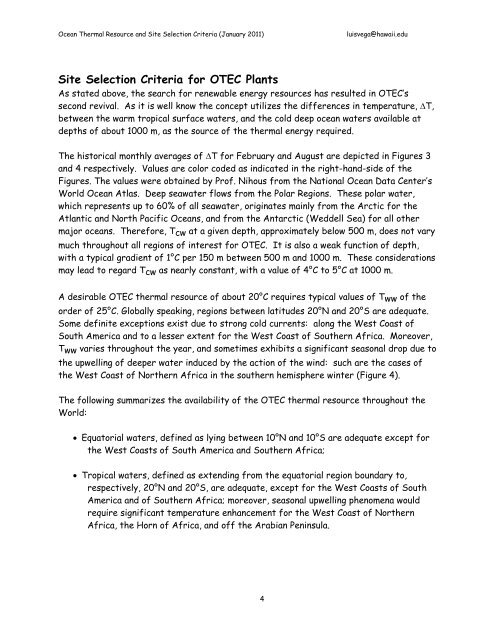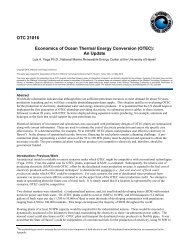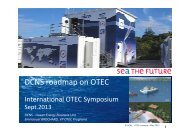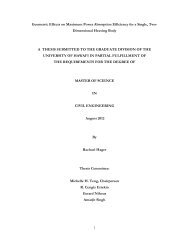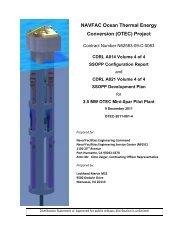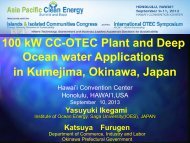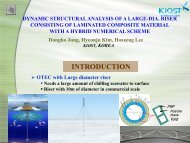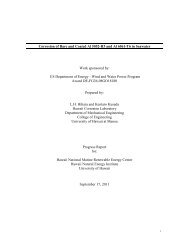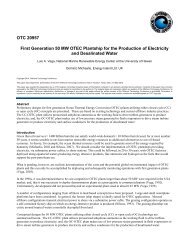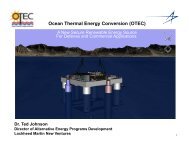Ocean Thermal Resources and OTEC Site Selection Criteria
Ocean Thermal Resources and OTEC Site Selection Criteria
Ocean Thermal Resources and OTEC Site Selection Criteria
You also want an ePaper? Increase the reach of your titles
YUMPU automatically turns print PDFs into web optimized ePapers that Google loves.
<strong>Ocean</strong> <strong>Thermal</strong> Resource <strong>and</strong> <strong>Site</strong> <strong>Selection</strong> <strong>Criteria</strong> (January 2011) luisvega@hawaii.edu<br />
<strong>Site</strong> <strong>Selection</strong> <strong>Criteria</strong> for <strong>OTEC</strong> Plants<br />
As stated above, the search for renewable energy resources has resulted in <strong>OTEC</strong>’s<br />
second revival. As it is well know the concept utilizes the differences in temperature, ∆T,<br />
between the warm tropical surface waters, <strong>and</strong> the cold deep ocean waters available at<br />
depths of about 1000 m, as the source of the thermal energy required.<br />
The historical monthly averages of ∆T for February <strong>and</strong> August are depicted in Figures 3<br />
<strong>and</strong> 4 respectively. Values are color coded as indicated in the right-h<strong>and</strong>-side of the<br />
Figures. The values were obtained by Prof. Nihous from the National <strong>Ocean</strong> Data Center’s<br />
World <strong>Ocean</strong> Atlas. Deep seawater flows from the Polar Regions. These polar water,<br />
which represents up to 60% of all seawater, originates mainly from the Arctic for the<br />
Atlantic <strong>and</strong> North Pacific <strong>Ocean</strong>s, <strong>and</strong> from the Antarctic (Weddell Sea) for all other<br />
major oceans. Therefore, Tcw at a given depth, approximately below 500 m, does not vary<br />
much throughout all regions of interest for <strong>OTEC</strong>. It is also a weak function of depth,<br />
with a typical gradient of 1°C per 150 m between 500 m <strong>and</strong> 1000 m. These considerations<br />
may lead to regard Tcw as nearly constant, with a value of 4°C to 5°C at 1000 m.<br />
A desirable <strong>OTEC</strong> thermal resource of about 20°C requires typical values of Tww of the<br />
order of 25°C. Globally speaking, regions between latitudes 20°N <strong>and</strong> 20°S are adequate.<br />
Some definite exceptions exist due to strong cold currents: along the West Coast of<br />
South America <strong>and</strong> to a lesser extent for the West Coast of Southern Africa. Moreover,<br />
Tww varies throughout the year, <strong>and</strong> sometimes exhibits a significant seasonal drop due to<br />
the upwelling of deeper water induced by the action of the wind: such are the cases of<br />
the West Coast of Northern Africa in the southern hemisphere winter (Figure 4).<br />
The following summarizes the availability of the <strong>OTEC</strong> thermal resource throughout the<br />
World:<br />
• Equatorial waters, defined as lying between 10°N <strong>and</strong> 10°S are adequate except for<br />
the West Coasts of South America <strong>and</strong> Southern Africa;<br />
• Tropical waters, defined as extending from the equatorial region boundary to,<br />
respectively, 20°N <strong>and</strong> 20°S, are adequate, except for the West Coasts of South<br />
America <strong>and</strong> of Southern Africa; moreover, seasonal upwelling phenomena would<br />
require significant temperature enhancement for the West Coast of Northern<br />
Africa, the Horn of Africa, <strong>and</strong> off the Arabian Peninsula.<br />
4


